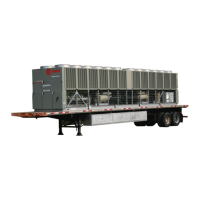RTAC-SVX005A-EN
27
tension, which stretches the hose out of the coupling; and
the bottom of the hose to be in compression, which causes
it to crimp. It also causes the hose to crimp at the ground.
Vertical Hose Installation
The following figures illustrate the correct and incorrect
methods for installing hose in a vertical hookup application.
In the configuration shown in Figure 21, p. 27, the hose is
installed with an elevation less than 7 feet off the ground. A
45° elbow is installed to reduce the stress in the hose
coupling connection. This elbow also directs the hose to
the ground at an appropriate angle to minimize the
crimping of the hose at the ground or supporting surface.
Figure 21. Correct vertical hose installation
Flexible Hose
Coupling
45° Elbow
Existing “Hard” Pipe
Ground
<7’
In the configuration shown in Figure 22, p. 27, the hose is
installed without an elbow and with an elevation greater
than 7 feet off the ground. This creates excessive stress at
the hose coupling connection. The hose will stretch,
separate from the coupling, and crimp at the ground.
Figure 22. Incorrect vertical hose installation
Flesible Hose
Existing “Hard” Pipe
Ground
>7’
Stretching
Hose Crimping
Horizontal to Vertical Installation
The following figures illustrate the correct and incorrect
methods for installing hose in a horizontal and vertical
combination application.
Figure 23. Correct horizontal to vertical installation
45° Elbow
90° Elbow
Hard Pipe
Ground
<7’
In this configuration, correct installation techniques
followed are:
• The hose is installed with elbows at both connection
ends.
• The vertical run of hose is less than 7 feet.
• The hose is adequately supported by more than half its
total length on the ground.
These items minimize the stretching and separation at the
hose-coupling interface and also the crimping of the hose
at the ground.
Figure 24. Incorrect horizontal to vertical installation
Ground
>7’
Stretching
Crimping
In this configuration, a number of improper installation
techniques can be noted:
• Elbows are not installed.
• The hose is completely supported by the couplings.
• The vertical run of hose is greater than 7 feet.
• The hose is not adequately supported by the ground.
These items cause excessive stress to be generated at the
hose-coupling interface, causing the hose to stretch and
separate from the coupling.
Installation - Mechanical

